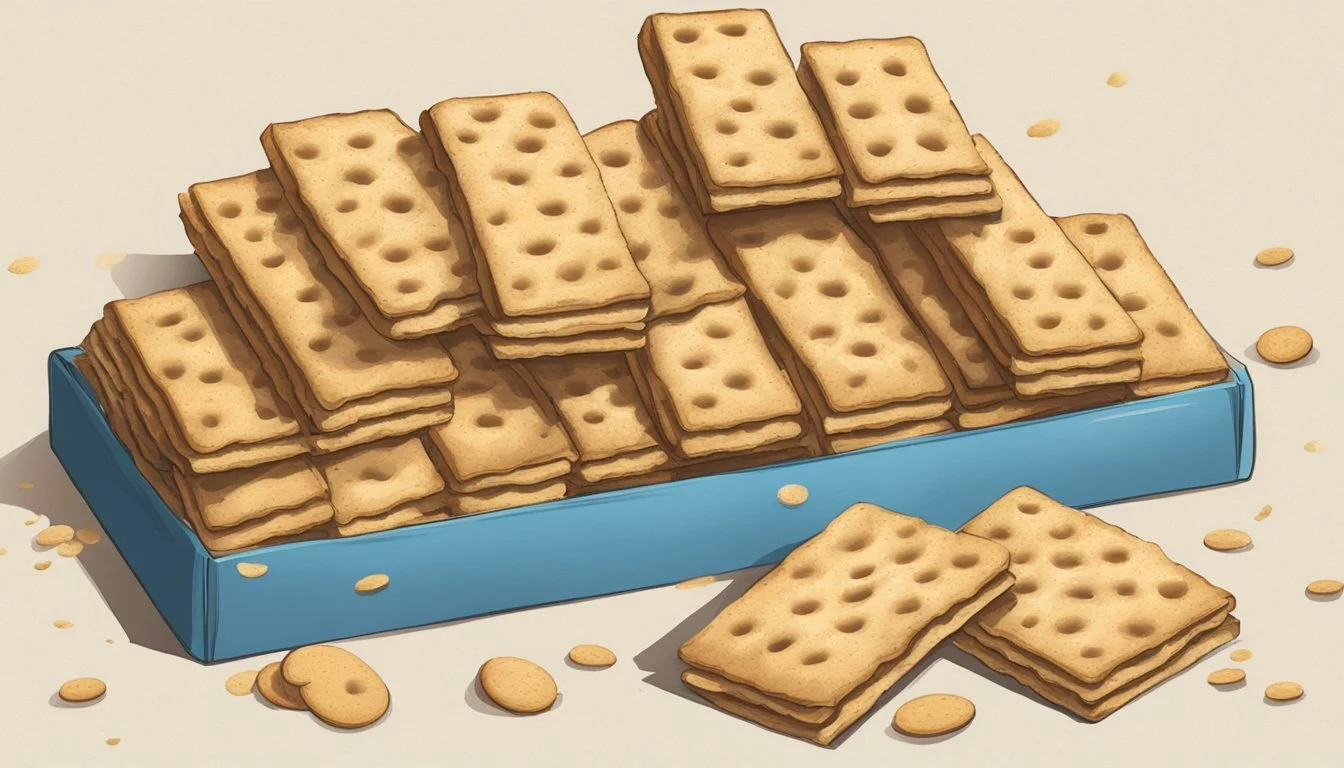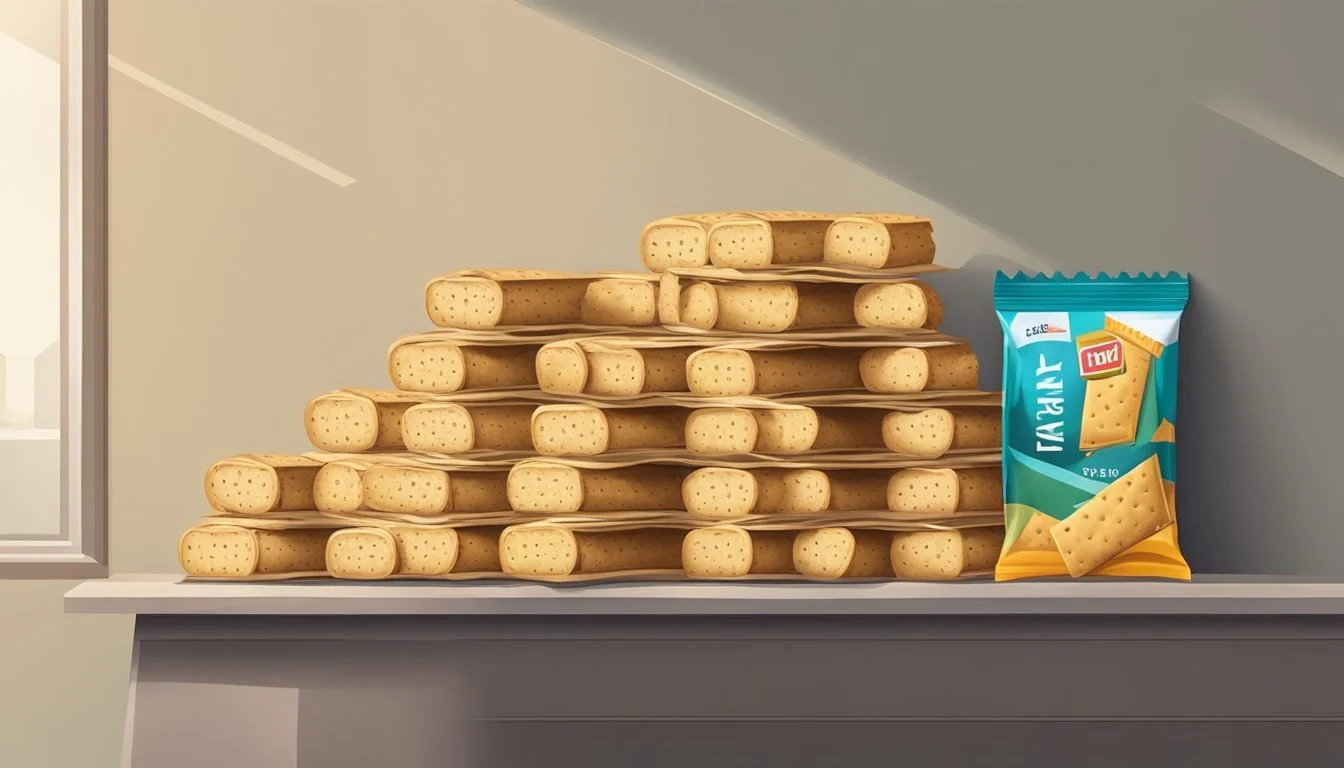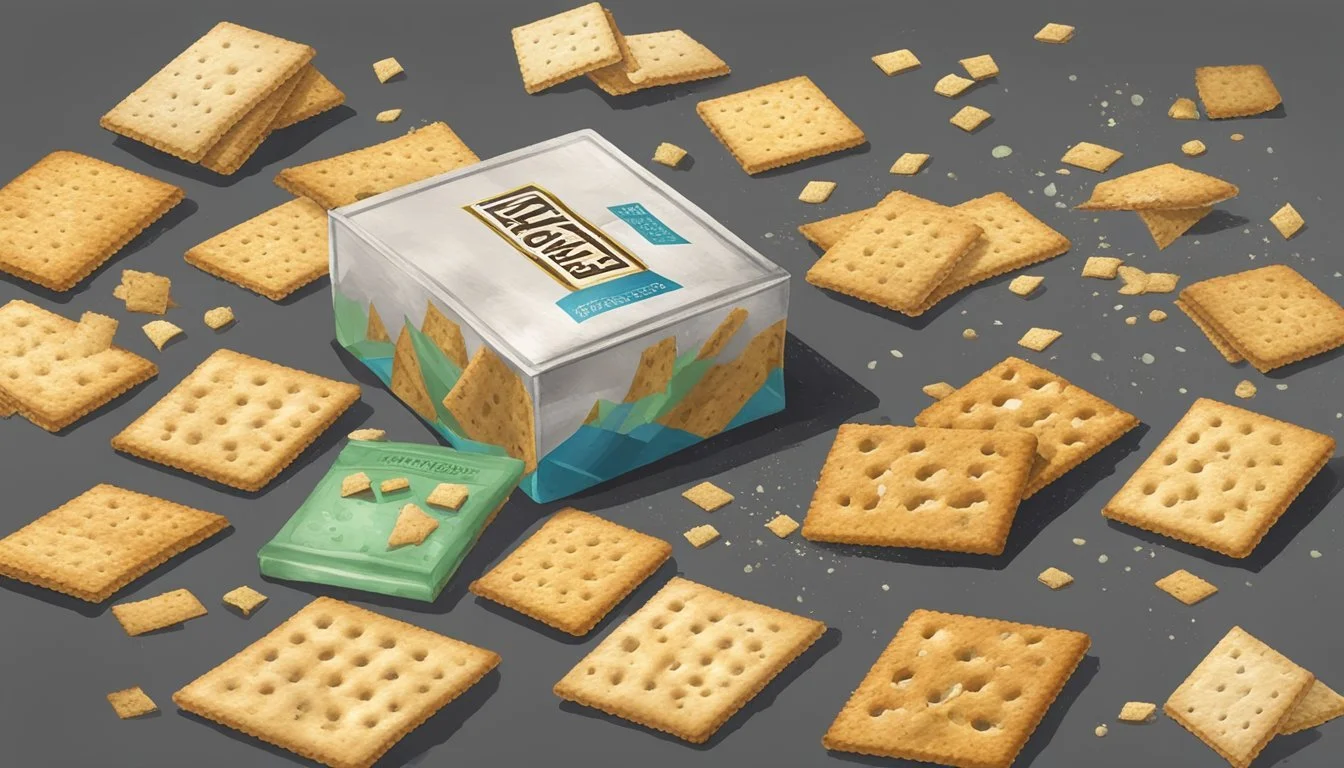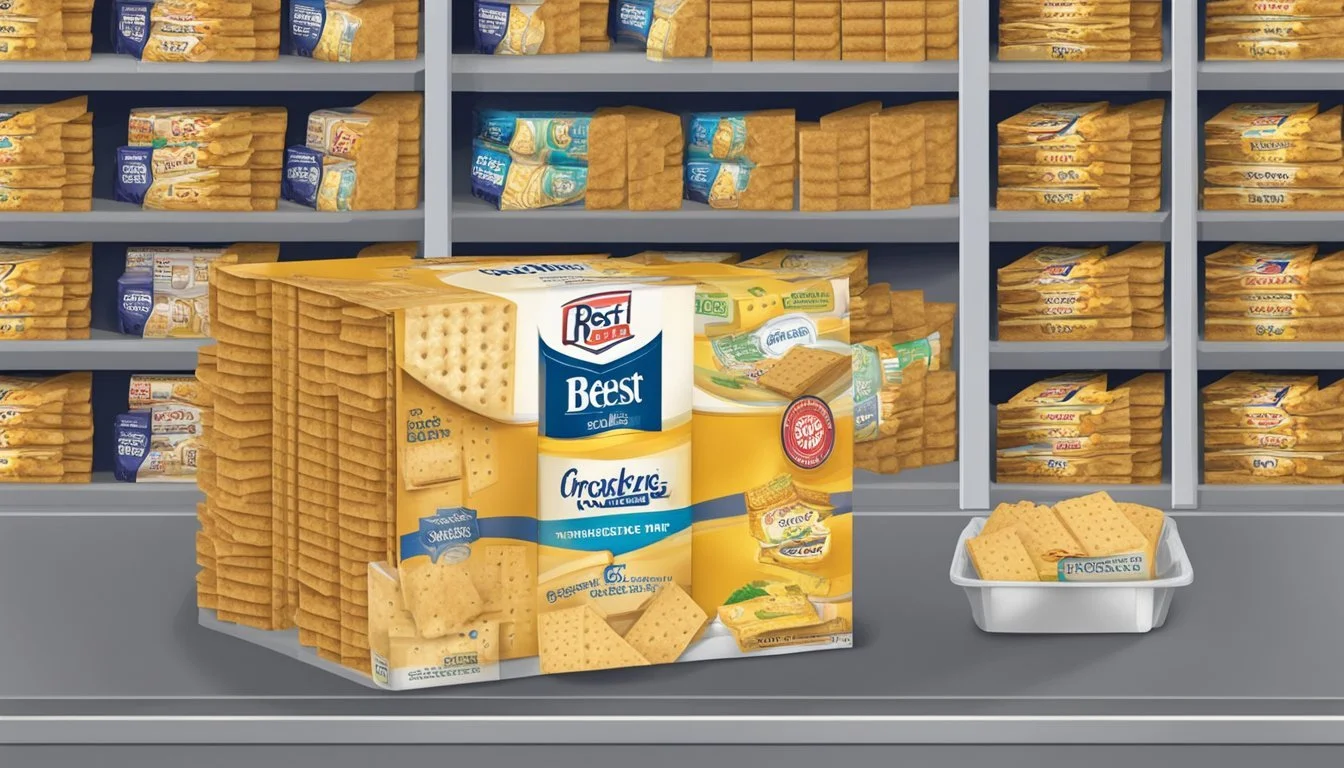Do Crackers Go Bad?
Understanding Shelf Life and Storage Tips
Crackers are a staple in many households, known for their crunch and versatility. Yet, an often-pondered question is whether these pantry items can actually go bad. Yes, crackers can and do go bad over time due to exposure to environmental factors such as humidity and heat.
Unopened packages of crackers, when stored correctly in cool, dry places, typically maintain their best quality for about 6 to 9 months, varying slightly depending on the type and ingredients. Nevertheless, while crackers might still be safe to eat after this period, they may lose their crispness and flavor, making them less enjoyable.
Understanding how long crackers last and knowing the signs of spoiled crackers can help in better managing pantry supplies and reducing waste. By paying attention to storage conditions, one can extend their shelf life and keep them tasting fresh longer.
Understanding Crackers as a Food Product
Crackers are a popular snack made from a variety of ingredients. The primary components include flour, oil, fat, salt, and sometimes preservatives.
Flour serves as the base ingredient, providing structure. Common types of flour used include wheat, rice, and multigrain. The choice of flour can affect the cracker's texture and flavor.
Oil and fat are added to create a crispy texture. These ingredients help keep the crackers light and flaky. Common oils used include vegetable oil, olive oil, and sometimes butter.
Salt enhances the flavor. It is a crucial component, especially in savory crackers, although some sweet varieties might reduce or exclude it.
Preservatives might be used to extend shelf life. These can help maintain the quality of the crackers over a longer period, preventing spoilage and staleness.
Typical Ingredients of Crackers:
Ingredient Purpose Flour Structure Oil/Fat Texture (crispiness) Salt Flavor enhancement Preservatives Shelf life extension
Crackers are designed to have a long shelf life due to their low moisture content. This reduces the risk of bacterial growth and mold formation. However, exposure to heat and humidity can still degrade their quality.
Proper storage is essential. Keeping crackers in a cool, dry place minimizes moisture uptake and helps maintain their intended texture and flavor.
Factors Influencing the Shelf Life of Crackers
Several critical aspects impact how long crackers can maintain their quality and freshness. These aspects include the type of packaging used, the storage conditions in which the crackers are kept, and the specific ingredients and additives included in the recipe.
Role of Packaging
Packaging serves as the first line of defense in maintaining the shelf life of crackers. Unopened crackers stored in airtight containers are protected from excess moisture and air, which can cause them to go stale.
Vacuum-sealed bags are another option; they help in minimizing contact with oxygen and prolonging freshness, although they may not be viable for very long-term storage. Fat-free crackers might last up to two years if properly packaged. The use of sealed packaging ensures protection against external contaminants, providing a barrier necessary for keeping crackers in optimal condition.
Importance of Storage Conditions
Storage conditions play a pivotal role in determining the shelf life of crackers. Cracker packages should ideally be kept in a cool, dry place to avoid exposure to moisture and high temperatures. Humidity is particularly detrimental as it leads to soggy, unpalatable crackers by causing them to absorb moisture.
Temperature extremes can also affect the structural integrity and flavor of crackers. Therefore, maintaining a stable environment by storing the crackers in standard pantry conditions can significantly extend their usable life. Proper storage not only preserves the taste but also protects the food from potential mold and bacteria growth.
Influence of Ingredients and Additives
The ingredients and additives used in crackers also influence their shelf life. Crackers with a higher fat content, such as Ritz, generally have a shorter shelf life due to the possibility of the fats going rancid. On the other hand, fat-free varieties have a longer shelf life and can last up to two years.
The use of preservatives helps in extending the expiration date by inhibiting the growth of mold and bacteria. Crackers with lower moisture content naturally have a prolonged shelf life because bacteria and mold growth is minimized. Understanding the composition of the crackers can aid in choosing products with longer shelf lives and better storage capabilities.
Identification of Spoilage
Determining whether crackers have gone bad involves checking for visual signs, changes in smell, and alterations in texture and taste. These indicators help ensure the crackers are safe and pleasant to consume.
Visual Signs
Spoiled crackers often show apparent visual changes. Mold growth is a primary sign, appearing as fuzzy spots that may be green, white, or even black. Changes in color are also common; crackers may look darker or exhibit discoloration. Observe the appearance closely for any unusual patterns or spots which indicate spoilage. Visible defects, such as cracks or excessive dryness, can signal that the crackers are no longer fresh.
Olfactory Indicators
The smell of crackers can reveal much about their quality. A stale or rancid odor suggests spoilage. Fresh crackers have a subtle aroma, while spoiled ones emit a distinctly off or sour smell. If there's any presence of mold, an unpleasant, musty smell is often noticeable. Always smell the crackers before consumption to confirm they haven't developed an undesirable scent, hinting at deterioration.
Texture and Taste Changes
Changes in texture are telltale signs of spoiled crackers. Fresh crackers have a crisp, firm texture. When they spoil, they become soft or stale. This change is linked to improper storage or moisture exposure. Flavor variations are also critical; spoiled crackers might taste sour or generally off. Taste a small piece to check for any signs of rancidity or a loss of the characteristic flavor.
Ensuring crackers maintain their quality involves regular checks for these spoilage signs.
Best Practices for Prolonging Freshness
To keep crackers fresh for as long as possible, it's vital to consider their storage environment, control for temperature and humidity, and use effective sealing methods. These measures help maintain the crackers' crispness and prevent spoilage.
Optimal Storage Solutions
Storing crackers properly is crucial to extending their freshness. An airtight container is your best friend for this purpose. These containers protect crackers from exposure to air and moisture, which can lead to staleness and spoilage.
Ensure that the container is also stored in a cool, dry place such as a pantry. Exposure to light and fluctuating temperatures can degrade the quality of the crackers over time. Keeping the storage location consistent helps preserve the crackers' longevity and freshness.
Temperature and Humidity Control
Temperature and humidity play significant roles in the shelf life of crackers. A cool environment helps maintain their optimal crispness. Excessive heat can cause the fats in the crackers to become rancid, affecting both flavor and texture.
Meanwhile, high humidity levels introduce moisture, which can make crackers soft and unappetizing. It's advisable to store crackers in a location where the humidity is low and the temperature remains constant.
Sealing and Re-Sealing Methods
Properly sealing and re-sealing crackers after each use is essential. Using an airtight container prevents exposure to air and moisture. If the original packaging is resealable, ensure it's closed tightly.
For packaging that isn't resealable, transfer the crackers to a sealable plastic bag before placing them in a cool, dry place. For extra protection, consider adding moisture absorbers like silica gel packets to the storage container. This additional step can help absorb excess moisture and prolong the freshness of the crackers.
Safety Considerations When Consuming Stale or Spoiled Crackers
When eating stale or spoiled crackers, safety is a primary concern. Crackers past their prime may still be safe to eat if they exhibit no significant signs of spoilage. Spoilage indicators include visible mold or an off smell, which suggest an unsafe food product.
Mold on crackers is a clear red flag. It often appears as white, green, or black spots. Consuming moldy crackers can lead to health issues, as they may contain harmful toxins produced by the mold.
Stale crackers will generally have a noticeable change in texture and taste. While stale crackers are not typically unsafe, their quality is reduced. If they simply taste bland or soft, they're likely fine to eat, but bacteria contamination is a concern if stored improperly.
Proper storage can prevent bacteria growth. Crakers should be kept in a cool, dry place. Unopened packages generally keep for 6-9 months past their expiration date if stored correctly. Always inspect the product before consuming.
In summary, assess crackers for spoilage signs such as mold and off odors. Stale crackers may lack flavor but are typically still safe to eat, provided they have been stored properly and show no mold or bacterial contamination. Proper storage habits can help extend their shelf life and reduce safety risks.
Maximizing Crackers Longevity and Usage
Proper storage methods can significantly extend the lifespan of crackers and even repurpose them creatively when they turn stale. Specific techniques and imaginative uses can help you make the most of this pantry staple.
Extending Shelf Life After Opening
Once a package of crackers is opened, storing them correctly is crucial. Airtight containers such as mason jars or vacuum-sealed bags help preserve freshness. Mylar bags with oxygen absorbers efficiently prevent air and moisture from degrading the crackers.
For bulk storage, placing the Mylar bags in a bucket can protect against physical damage and keep away pests. Ensure the storage area is cool and dry to maximize longevity. Low-fat or fat-free crackers are less prone to rancidity and thus last longer even after opening.
Creative Uses for Leftover or Stale Crackers
Stale or leftover crackers need not go to waste. Transform them into breadcrumbs by crushing them finely and use them in cooking. Breadcrumbs made from crackers can be substituted in recipes for breaded dishes like chicken or fish, adding an extra crunch.
To revive their texture, toast crackers in the oven at a low temperature for a few minutes. This method can restore some of the original crispness. Additionally, use stale crackers in soups or salads, where their slightly altered texture enhances the dish rather than detracts from it.
Appropriate Selection and Pairing
When choosing and pairing crackers, the type of cracker and accompanying foods can significantly enhance the dining experience. Selecting the right kind of cracker based on occasion and pairing it with complementary foods ensures that both flavors and textures are highlighted.
Choosing the Right Type for the Occasion
Selecting the appropriate cracker depends on the event and the foods being served. For formal cheese tasting, water crackers and rice crackers offer neutral bases that let the flavors of aged cheeses like Gouda and Parmigiano Reggiano shine. Saltines are excellent for casual gatherings, enjoyed with spreads like chicken salad or hummus.
Graham crackers can be used for sweet pairings, perfect with desserts or peanut butter. For durability and a rustic touch, hardtack complements robust foods like smoked meats or sharp cheddar. Crispbread adds a crunchy texture, ideal for Scandinavian-style open sandwiches.
Event Type Recommended Crackers Formal Water Crackers, Rice Crackers Casual Saltines, Graham Crackers Sweet Pairings Graham Crackers Rustic/Heavy Foods Hardtack, Crispbread
Complementing Foods and Recipes
Pairing crackers with suitable foods enhances both the cracker and the topping. Cheese pairs well with various crackers: Brie on Raincoast Crisps for a combination of creaminess and crunch, or Blue Cheese on whole wheat crackers for a satisfying bite. Peanut butter pairs beautifully with saltines, creating a delightful balance of salt and creaminess.
For savory bites, top crispbread with avocado and smoked salmon or butter and radishes. Salty snacks like olives and cured meats go wonderfully with water crackers. Versatility is key with rice crackers, which can handle everything from soft cheeses to spicy tuna.
Cracker Type Common Pairings Water Crackers Blue Cheese, Tuna, Cured Meats Saltines Peanut Butter, Chicken Salad Rice Crackers Soft Cheeses, Spicy Tuna Crispbread Avocado, Smoked Salmon
Decoding Food Expiration Labels
Reading food expiration labels helps consumers understand when products are at their peak quality and ensures safe consumption. Clarifying terms such as "best-by" and "sell-by" dates reveals their true purpose, while dispelling common misconceptions about expiration and quality.
Understanding 'Best-By' and 'Sell-By' Dates
Best-by date indicates the period during which the product maintains its highest quality. It's not a strict expiration date, so food items may still be safe to eat after this date, though they might not taste as fresh.
Sell-by date guides retailers on how long to display the product for sale. It doesn't mean the item is unsafe post this date, just that it might start losing its optimal quality and freshness.
Most labels also use packaging dates to inform when the item was packed. This is crucial for foods that are less processed. Understanding these terms ensures safe consumption and reduces waste.
Misconceptions about Expiration and Quality
Many people equate expiration dates with immediate spoilage, which isn't always accurate. For non-perishable items like crackers, unopened packages can still be safe and maintain quality months past the expiration date if stored properly.
It's essential to differentiate between peak quality and safety. While the former relates to taste and texture, the latter concerns health risks. Spoiled food shows signs like mold or an off smell—these indicators are more reliable than just the date on the label.
Consumers often discard edible food based on misinterpreted labels. Knowing the difference between various dates helps in making informed decisions that prioritize both safety and quality.
Conservation and Sustainability Efforts
Conservation and sustainability efforts are essential in reducing waste and helping communities in need. Specific strategies focus on minimizing food waste and supporting food banks with donations.
Strategies to Reduce Waste
Reducing waste involves several practical strategies. For example, proper storage techniques can considerably extend the shelf life of crackers, helping to prevent them from going stale prematurely. Cool, dry places are optimal for cracker storage.
Packaging can also play a significant role. Environmentally-friendly packaging not only keeps crackers fresh but also reduces the amount of landfill waste. Recyclable materials and minimalist designs are effective in achieving this goal. Manufacturers are increasingly adopting these methods to enhance sustainability.
Consumer education is another vital strategy. Teaching consumers how to store crackers properly and creatively use them in meals helps reduce wastage. This can involve community workshops or social media campaigns that share practical tips and recipes.
Donating to Food Banks
Donating crackers to food banks is a meaningful way to address both food waste and food insecurity. Food banks can distribute these items to families who might otherwise go without.
Though crackers can go bad, those that are just past their best-before date can often still be used. Many food banks accept such items, provided they are not significantly expired. This assists in diverting food from landfills while supporting those in need.
Coordination between manufacturers, retailers, and food banks is crucial. Efficient logistics can ensure that surplus crackers are quickly and safely transported to food banks. This reduces the risk of spoilage and maximizes the utility of these donations.
Volunteer efforts also play a significant role. Volunteers help sort, pack, and distribute donated crackers, supporting food banks in their mission to combat hunger and reduce waste.
Alternative Storage Methods Beyond the Pantry
For long-term storage, refrigeration and freezing options can preserve crackers, while specialized preservation techniques provide additional methods to keep them fresh and edible.
Refrigeration and Freezing Options
Storing crackers in the refrigerator can extend their shelf life. The cool environment slows down the degradation of oils in the crackers, preventing rancidity. Crackers stored this way should be placed in an airtight container or sealed bag to avoid moisture absorption.
Freezing crackers is another effective method. This prevents any remaining oils from becoming rancid and keeps the crackers crisp. When freezing, use a freezer-safe airtight container or heavy-duty freezer bags. To consume, thaw them at room temperature. Slices of bread can also be placed in the container to absorb any excess moisture, maintaining the crackers' crunch.
Specialized Preservation Techniques
Beyond refrigeration and freezing, vacuum sealing is a key preservation method. Vacuum-sealed bags remove air and keep the crackers fresh by eliminating oxygen, which contributes to spoilage. Desiccants can be added to the packaging to absorb moisture and further extend shelf life.
Silica gel packets are another option for controlling moisture. These packets can be included in storage containers to absorb humidity. For those looking for long-term solutions, specialized food-grade containers with hermetically sealed lids can protect crackers from air and pests, ensuring a shelf-stable environment. Keeping the container in a cool, dark place enhances the preservation.
Frequently Asked Questions Regarding Cracker Storage
How long do crackers last?
Unopened crackers typically last between 6 to 9 months if stored properly. Once opened, they might last several weeks depending on the storage conditions.
Do crackers go bad?
Yes, crackers can go bad. Factors like exposure to moisture, heat, and air can lead to spoilage. They may become soggy, lose flavor, or even develop microbial growth if storage conditions are poor.
Can crackers expire?
Crackers often have a "best-by" date rather than an expiration date. While they may still be safe to eat after this date, their quality might decline.
What's the best way to store crackers long-term?
Store crackers in a cool, dry place. For long-term storage, use Mylar bags with oxygen absorbers inside a sealed bucket. This method can extend the shelf life of fat-free crackers to about 10 years.
What can affect the shelf life of crackers?
Factors include the type of cracker, the ingredients, and how they are packaged and stored. Exposure to air and humidity significantly reduces their shelf life.
What are the signs that crackers have gone bad?
Check for changes in texture, taste, and smell. Soggy texture, off flavors, and unusual smells indicate spoilage. Always ensure packets are intact to avoid contamination and spoilage.
Do crackers last longer if refrigerated?
Refrigeration isn't necessary for most crackers. Keeping them in a cool, dry pantry works well. However, in very hot climates, refrigeration may help maintain their quality by reducing moisture exposure.











